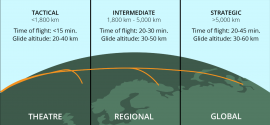The problem was never tracking these weapons systems. The technology exists. The problem is intercepting them.
The interceptor needs to be faster than the weapon to have a chance of working.
Terminal phase interception also means you need to cover all possible targets with defense systems. That is never going to work.
The interceptor needs to be faster than the weapon to have a chance of working.
Terminal phase interception also means you need to cover all possible targets with defense systems. That is never going to work.


